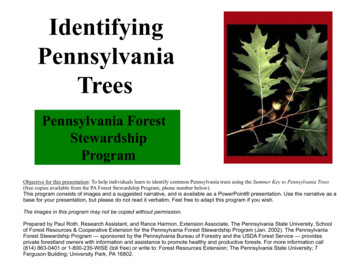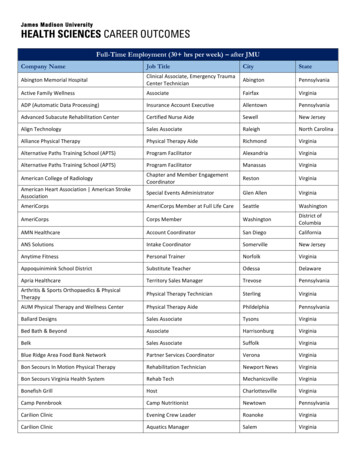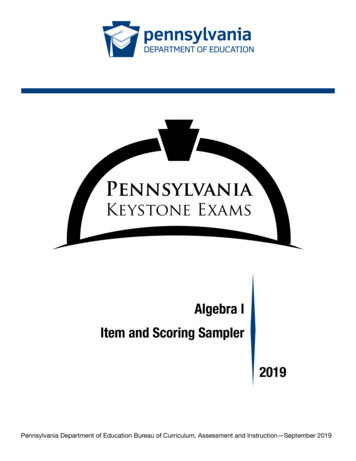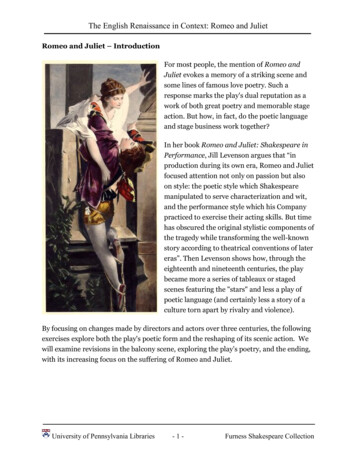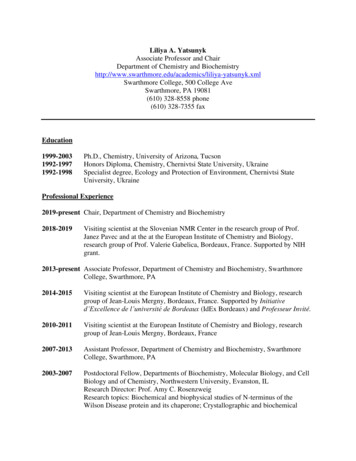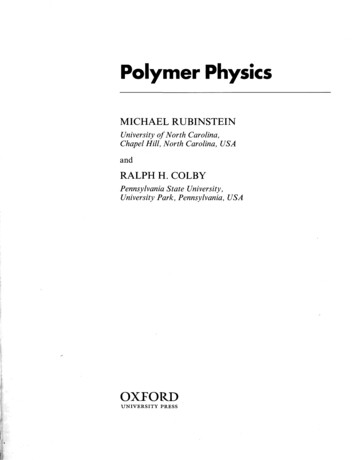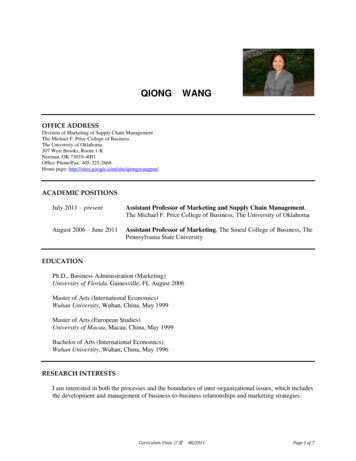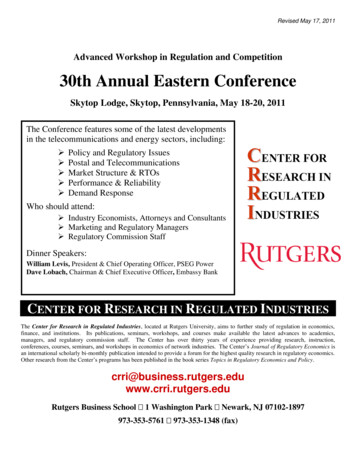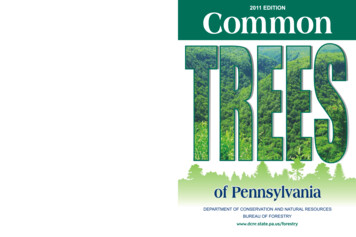
Transcription
iIntroductionThe trees of “Penn's Woods”—the translation of our state'sLatin name—have supported people in what is nowPennsylvania for thousands of years. Trees are essential toour lives. They act as living filters, cleaning the air webreathe and the water we drink. They help heat our homesand cool our streets. They provide us flooring, cabinets,medicines, maple syrup, paper and countless otherproducts. They are sources of the inspiration and beauty thathelp define Pennsylvania.When early European settlers arrived in the state 400 yearsago, almost all of the land was forested. Slowly, they clearedthe land for agriculture and for fuel, housing andmanufacturing. As the nation grew, the pace of land clearingquickened. By the early 1900s, nearly all of Pennsylvania'sforest had been cut or burned.Careful management during the last century has restoredmuch of the forest. Today, forests blanket 60 percent ofPennsylvania. Although only a few stands of its originaltimber remain, the state now has thriving forests that providea wealth of benefits to its citizens.About 134 native and 62 introduced tree species growacross Pennsylvania. Its range of topography andclimate—from coastal plain to mountain ridge-top and highplateau—allows the Commonwealth to support the manydifferent kinds of trees that make our forests unique andspecial.Use this book to learn about and explore the trees andforests where you live—on a tree-lined street, a timberedmountainside or in a wooded valley.
iiExplore Our State ForestsPennsylvania is blessed with 2.2 million acres of state forestland for you to enjoy and explore. These forests belong tothe citizens of Pennsylvania. The Department ofConservation and Natural Resources Bureau of Forestrymanages them for their long-term health and productivity.State forests are vast and remote. They offer unparalleledscenic beauty and boundless recreational opportunities.They are known for their extensive network of trails,awesome scenic vistas, flaming fall foliage and picturesquedrives. Hiking, hunting, fishing, mountain biking, primitivecamping, wildlife watching and picnicking are all popularactivities.But our state forests are much more than places to enjoyand recreate in. They are working forests, managed toprovide wood products, clean air and water, and evenenergy sources such as firewood and natural gas. They arereservoirs of biological diversity, and play a valuable role inconserving important plant and animal communities.Each of Pennsylvania's 20 state forests offers somethingspecial and unique, from the remote glacial ponds of theDelaware State Forest to the trails and vistas of the Michaux,the high ridges of the Forbes or the waterfalls of theLoyalsock.To learn more, visit www.dcnr.state.pa.us/forestry, or call(717) 787-2703.
iiiTree Identification TipsHere are some tips to help you learn about Pennsylvania'smost common trees:Carefully study the tree you want to identify. Look atleaves, twigs, buds and any flowers or fruits.When the leaves have fallen, you can still identify trees.It takes careful study of their twigs, buds, leaf scars andbark, and a little practice.Individual trees vary in their characteristics. The amountof sun a leaf receives affects its shape. And bark oftenvaries with the age of the tree—younger trees are oftensmoother and more lightly colored.Species that look similar can often be distinguished bytheir typical habitat.
ivSharing Trees with ChildrenCollecting tree leaves, nuts, pods or cones is a fun way tointroduce kids to the natural world and sharpen theirobservation skills. Other activities you can use to bringnature home and foster an appreciation for trees include:Keep a nature journal or scrapbook: Draw pictures oftree twigs, barks or leaves. Write down the kinds of treesyou saw in the woods.Make a leaf collection: Place a leaf between two layersof waxed paper and cover with a towel. Press the towelwith a warm iron, being sure to cover all the wax paperon both sides. Cut out each leaf leaving a narrow marginof waxed paper around the edges. If you cut the paper abit wider at the tip of the leaf, you can punch a hole,attach string and use your leaves, some twigs and otherparts to make a leaf and branch mobile.Do a bark or leaf rubbing: For bark, hold a piece ofpaper against the tree and rub it lightly with a crayon,pencil or artist charcoal. Make leaf rubbings by laying aleaf vein-side up on a smooth surface. Cover with apiece of paper. Rub gently with crayons from side-toside across the paper and the leaf image will appear.
vHelp Conserve Penn’s WoodsWe all live in “Penn's Woods,” and play an important role inconserving the trees and forests that give Pennsylvania itsname. Take the time to learn more about these action steps:Plant native trees and plants where you live.Care for your trees to ensure their long-term health.Identify and manage invasive species on your property.Plan for and manage your forest or woodlot.Consult a qualified professional before harvesting orpruning trees.Shop for local, sustainable wood products.Help prevent wildfires.Encourage land-use planning in your community thatconserves trees and forests.Join an organization that promotes forest conservation.Learn more about how you can help conserve Penn's Woodsat www.iConservePA.org or www.dcnr.state.pa.us/forestry.
viUsing this GuideThis selection of Pennsylvania native trees is organizedaccording to leaf shape and arrangement. Six commonintroduced species are listed separately. Each tree isidentified by a popular name familiar to Pennsylvanians andits complete scientific name. The most significant featuresfor identification are described in italics.Studying leaves is usually the easiest way to identify a tree.Compare leaves of the tree you wish to identify with thedrawings of “needle-like”, “simple” and “compound” leafshapes and “alternate” and “opposite” leaf arrangements onpages viii and ix. Buds that will produce next year's twigsand leaves are found where the leaf stalk joins the twig. Leafblades divided into compound shapes of separate leafletsstill have buds at the base of the leaf stalk but never at thebases of the leaflets.Conifers have narrow, needle-shaped leaves and in addition,Eastern redcedar has tiny scale-like leaves closely pressedto their twigs. On spruces and hemlock the needles areattached individually by a tiny stalk. The needles of pines areattached in bundles of two, three or five.The tree key makes it easy to find the pages illustrating treeswith each leaf type. In fall and winter compare thearrangement of leaf scars, buds and other twig characters tothe illustrations. A glossary is provided in the back of thebook to clarify unfamiliar terms.
viiTree KeyNative treesLeaves needle-shaped or linear .page 1-8Leaves wide and flatLeaves in opposite arrangementLeaf shape simple .page 9-14Leaf shape compound .page 15-16Leaves in alternate arrangementLeaf shape simple .page 17-49Leaf shape compound .page 50-58Introduced treesBlue spruce.page 59Norway spruce.page 60Scots pine .page 61Catalpa .page 62Norway maple.page 63Tree-of-heaven .page 64
viiiParts, Types, And PositionsOf nateOpposite
ixScale-like(Red Cedar)Linear(Hemlock)Awl-likeNeedle-like(Red Cedar)(White Pine)Pinnately Compound(White Ash)Pinnately LobedParallel-veined leafof the Ginkgo(White Oak)Palmately Lobed(Red Maple)Palmately Compound(Ohio Buckeye)
xDiagram Showing Functions Of Different Parts Of A TreeLEAVESThe air supplies carbon,the principal food ofthe tree, which istaken in on the undersurface of the leaves.MEDULLARY RAYSconduct food andwater radially, servein food storage.HEARTWOOD(inactive cells)adds structural support.SAPWOODcarries food and waterupward.PITHCAMBIUMgrowing layer, cellsdivide here to formboth bark and wood.INNER BARKcarries food made inthe leaves downwardto cambium andstorage cells.ANNUAL RINGSindicate growth,normally one ringper year.OUTER BARKinactive cells form protection for inner barkSOILbacteria and fungimake available soilnutrients.ROOTSabsorb food elementsthrough the tiny roothairs, also provideanchorage.Courtesy of the New Tree Experts Manual by Richard R. Fenska
1Eastern HemlockTsuga canadensis (L.) Carr.LEAVES: Evergreen needles occur singly, appearing 2-ranked on twigs,flattened, ½" – ¾" long, dark green and glossy above, light green with 2 whitelines below.TWIGS: Slender, tough, yellowish brown to grayish brown. Buds eggshaped, ¼16" long, reddish brown.FRUIT: Cones ¾" – 1" long, egg-shaped, hanging singly from the tips oftwigs. Under each scale are 2 small, winged seeds.BARK: Flaky on young trees, gray brown to red brown, thick and roughlygrooved when older.A large, long-lived tree, capable of reaching heights of 140 feet. Historically,hemlock contributed construction timber and tannic acid for tanning leather toPennsylvania's economy. Found in cool, moist woods throughout theCommonwealth, Eastern hemlock is the official state tree of Pennsylvania.Ruffed grouse, Wild turkey and songbirds find food (seeds) and shelter in thistree. Deer browse it heavily when deep snow makes other foods scarce.
2Eastern RedcedarJuniperus virginiana L.LEAVES: Evergreen, opposite, of two types, the older more common kindsare scale-like and only 1/16"-¾32" long, while the young sharp-pointed onesmay be up to ¾" in length; whitish lines on the upper surface.TWIGS: Slender, usually 4-sided, becoming reddish brown. Buds smalland not readily noticeable.FRUIT: Bluish, fleshy, berry-like cones, with a white waxy coating, about¼" in diameter; flesh sweet and resinous; contains 1-2 seeds. Cones ripenin one growing season.BARK: Reddish brown, peeling off in stringy and flaky strips.A slow growing and long-lived tree, to 40' high. Redcedar is adaptable to avariety of wet or dry conditions. It is a common pioneer species inabandoned farm fields in the southern tier counties and on rocky bluffs. Therot-resistant wood is used chiefly for fence posts and moth-proof chests.Cedar waxwings and other song birds and game birds eat the fruits.
3Pitch PinePinus rigida P.Mill.LEAVES: Evergreen needles in clusters of 3, stiff, 2"-6" long, yellowishgreen.TWIGS: Stout, brittle, rough, angled in cross-section, golden-brown. Budsegg-shaped, about ½" long, resinous, red-brown.FRUIT: Cones 2"-3" long with short, stiff prickles, nearly stalkless, oftenremain attached for 5 years or more after ripening. Many remain unopeneduntil being heated by passing forest fire.BARK: Green and smooth on young branches, thick, rough, grayish brownon older trunks.Pitch pine is a medium sized tree, 50'-60' high and widespread inPennsylvania except the northwestern counties. This fire-adapted specieshas thick bark which insulates and protects the trunk from damage. Itprospers on poor, sandy soils as well as in upland bogs. Its resinous woodis very durable and used for railroad ties, sills of houses and barns and fuel.Pine tar and turpentine are distilled from Pitch pine. Its seeds are importantto nuthatches, Pine grosbeak and Black-capped chickadee. Deer andrabbits browse the seedlings.
4Red PinePinus resinosa Ait.LEAVES: Evergreen needles in clusters of 2, slender, 4"-6" long, darkgreen, borne in dense tufts at the ends of branchlets; Fresh needles snapcleanly when bent double.TWIGS: Stout, ridged, yellow-brown to red-brown, buds egg-shaped, about½" long, brown at first and later silvery.FRUIT: A cone, about 2" long, without prickles, nearly stalkless, remainsattached until the following year.BARK: Comparatively smooth, reddish brown. Upper trunk and brancheslight reddish orange.Like White pine, this medium to large-sized tree develops one horizontalwhorl of side branches each year, growing up to 110 feet. A valuable timbertree in the northern part of the State, its wood is used chiefly forconstruction lumber and pulp. Red pine is native to dry slopes in Luzerne,Wyoming, Tioga, and Centre counties and planted extensively by theBureau of Forestry and the Pennsylvania Game Commission. Songbirds,mice and chipmunks feed on the seeds.
5Table Mountain PinePinus pungens Lamb.LEAVES: Needles in clusters of 2, 1"-3" long, light bluish-green, stout andvery stiff, twisted and sharp-pointed, tufted at the ends of branches,persisting 2-3 years.TWIGS: Stout, rather brittle, at first smooth and light orange to purplish,later rather rough and dark brown.FRUIT: Cones 3"-4" long, sessile, egg-shaped but asymmetrical at thebase, in whorls of 2-7. Cone scales much thickened and tipped with astrong, curved spine.BARK: Dark reddish-brown, roughened by shallow fissures into irregularplates which peel off in thin films.This Appalachian endemic species attains a height of 30'-40' on dry, rockyand gravelly slopes and ridgetops in the southcentral and southeasterncounties. Not usually used for lumber due to its small size, it can displayaggressive growth suited to protecting rocky slopes from erosion.
6Virginia PinePinus virginiana Mill.LEAVES: Evergreen needles in clusters of 2, twisted, stout, relatively short1½"-3" long.TWIGS: Slender, curved, flexible, brown to purple with bluish white coating.Buds egg-shaped, usually less than ½" long, brown and resinous.FRUIT: Cone 2"-3" long, prickles small but sharp, edge of scales withdarker bands, usually without a stalk, many remain attached for 3 or 4years.BARK: Smooth, thin, reddish brown and scaly, shallowly fissured into smallflat plates.Also called Scrub pine, this irregularly shaped small tree attains a height of40'–50' or more on sandy or poor rocky soils of barrens and ridgetops.Virginia pine is a southern species that reaches its northern limit inPennsylvania. It is valuable as cover for worn-out farmlands and isharvested for pulpwood. Virginia pine is not tolerant of shade or fire. Theseeds are eaten by squirrels, songbirds and game birds. Caterpillars of theeastern pine elfin butterfly feed on the needles of this tree as well as pitchand short-leaf pine.
7Eastern White PinePinus strobus L.LEAVES: Evergreen needles in clusters of 5, soft flexible, 3-sided, 2"-5"long, and bluish green. This is the only pine native to Pennsylvania with 5needles per cluster.TWIGS: Slender, flexible, with rusty hairs when young, later smooth. Budsegg-shaped, usually less than ½" long, gray-brown. Each whorl of branchesrepresents a year's growth.FRUIT: Cones 4"-7" long, without prickles, slightly curved, resinous; eachscale usually bears 2 winged seeds as do all our native pines.BARK: Young trunks and branches greenish brown, later darker groovedand scaly.Eastern white pines are large trees. At present they usually reach 50'-90'high but the original "Penn's Woods" saw white pines reaching 170' andmore. It is one of the most valuable timber trees, found in moist or drywoodlands throughout the state and often planted as an ornamental in largeopen areas. Many birds, squirrels, chipmunks and mice feed on the seedsand soft needles. Inner bark of white pine is a preferred winter food ofporcupine and deer browse the twigs.
8American Larch, TamarackLarix larcina (Duroi) K.KochLEAVES: Needles not evergreen; occur singly near the ends of the twigs,elsewhere in clusters of 10 or more; about 1" long, pale green, turningyellow and falling from the tree during autumn.TWIGS: At first covered with a bluish white coating, becoming dull brownand with numerous short spurs. Buds round, small, ¼16" long, dark red.FRUIT: A cone, about ½" long, egg-shaped, upright, matures in fall andoften remains attached for several years.BARK: Smooth at first, later becoming scaly, dark brown.Tamarack is a medium-sized tree growing to 60' in sphagnum bogs of theglaciated northeastern and northwestern corners of the Commonwealth. It isthe only cone-bearing native tree that loses its needles annually. Its wood isused chiefly for paper pulp, lumber, posts and railroad ties. European larch(L. decidua) and Japanese larch (L. leptolepis) are more commonly plantedin the state. They can be distinguished from American larch by their largercones, 1-1½" long.
9Flowering DogwoodCornus florida L.LEAVES: Opposite, simple, 3"-5" long; clustered toward tips of twigs;margins smooth or wavy; veins prominent and curved toward the leaf-tip.Foliage turns wine-red in autumn.TWIGS: Red tinged with green, often with a bluish white powdery coating;marked with rings; tips curve upward. End leaf bud covered by 2 reddishscales; side leaf buds very small; flower buds conspicuous, silvery, buttonshaped, at ends of twigs.FRUIT: An egg-shaped red drupe, ½" long; usually in clusters of 2-5.Flowers greenish white or yellowish, small, in flat-topped clusters; fourshowy white bracts underneath open before the leaves.BARK: Light to dark gray, broken by fissures into small blocks.A small native tree growing to 30' with low spreading crown adapted to life inthe shade of maples, oaks and hickories. Its extremely hard wood was usedprimarily for textile weaving shuttles, wheel hubs and bearings. Valued forornamental planting horticultural varieties with red or pink bracts have beendeveloped. Dogwood anthracnose disease killed about 75% ofPennsylvania's forest and ornamental dogwoods during the 1980s. Morethan thirty-six species of birds are reported feeding on the fruits.
10Red MapleAcer rubrum L.LEAVES: Opposite, simple, with 3-5 shallow lobes, coarsely toothed, lightgreen above, pale green to whitish beneath, turning brilliant red or orange inautumn.TWIGS: Slender, glossy, red or grayish-brown.FRUIT: Winged seeds called samaras, usually less than 1" long, in pairsspreading at a narrow angle, mature in Spring.BARK: Smooth and light gray on young trunks and branches, older trunksdarker, shaggy and roughened with long, irregular peeling flakes.The most abundant tree in Pennsylvania growing in a wide variety ofhabitats, typically reaching 80-100' high. It grows best in wet soils. Knownas soft maple because its wood is not as hard as Sugar maple, this is anexcellent ornamental tree. Young trees are heavily browsed by deer andrabbits; rodents consume the seeds.
11Silver MapleAcer saccharinum L.LEAVES: Opposite, simple, deeply 5-lobed and coarsely toothed, about 5"wide, bright green above, silvery-white beneath. Fall color is a greenishyellow.TWIGS: Slender, glossy, green in spring, turning chestnut brown. Lowerbranches have a distinctive upward curve at the end.FRUIT: Largest of the native maples, wings 2" long widely spreading,maturing in spring.BARK: Smooth and gray on young trunks, older trunks brown and furrowedwith plates that curl out on both ends.Found in moist woods and on stream banks throughout Pennsylvania, thelargest reaching 100' high. Many mammals and birds eat the seeds. Plantedas a shade tree but it has a tendency to split.
12Striped MapleAcer pensylvanicum L.LEAVES: Opposite, simple, 3-lobed, rounded at the base, with finelytoothed margins and rusty pubescence on the lower surface when young.TWIGS: Smooth stout at first greenish, later red; pith brown; each seasonsgrowth marked by 2 or 3 dark lines encircling the twig.FRUIT: Wings very divergent, about ¾" long, maturing in September indrooping clusters. Marked on one side of the seed with a depression.BARK: Smooth greenish or reddish brown, conspicuously marked withlongitudinal white streaks; older trunks rougher, darker and less streaked.Usually from 10'-25' high; common in the mountainous parts of the state onmoist, cool, shaded slopes and in deep ravines. Its distinctive white stripesmake it an attractive ornamental species.
13Mountain MapleAcer spicatum Lam.LEAVES: Opposite, simple, 6” long with 3-5 lobes and a coarsely toothedmargin. Smooth on the upper surface and hairy on the underside, they turnorange or yellow in autumn.TWIGS: Finely hairy, reddish-purple and yellowish-green at first aging tograyish brown. Narrow V-shaped leaf scars below ¼" grayish or greenishbuds.FRUIT: Wings of the samaras slightly spread, ½" long. Green to red fruitsripen in September or October in clusters at the twig-ends.BARK: Thin, rather smooth and brown to grayish-brown mottled with grayblotches.Mountain maple is a shrub or small tree of the forest understory, reaching25 to 30' high. Its short trunk bears rather straight, slender upright brancheson cool, moist rocky hillsides and in ravines under sugar maple, yellowbirch, beech, white pine and hemlock. More common in northern countiesand at higher elevations of the Ridge and Valley and Allegheny Mountainphysiographic provinces, it provides browse for deer, rabbits, and beaver.Ruffed grouse feed on its buds.
14Sugar MapleAcer saccharum Marshall.LEAVES: Opposite, simple, 5-lobed, the basal lobes short, with a few largeteeth, 3-5” long, bright green above, pale green below. Leaves turn brightyellow, orange or red in autumn.TWIGS: Reddish-brown to orange-brown. Buds brown and sharp pointed.FRUIT: Double samaras with wings varying from almost parallel to rightangled, maturing in autumn.BARK: Gray brown, smooth on young trunks, older trunks fissured withlong, irregular flakes.Also called Rock maple for its hard wood, this important timber tree is foundon moist wooded slopes throughout Pennsylvania, typically reaching 90'high. Sugar maple wood is used for furniture, musical instruments andflooring and the sap is tapped for maple syrup production. Sugar maple isan excellent ornamental tree for large open areas. Birds and rodents eat theseeds. Deer, squirrels, porcupine and other mammals browse the twigs,buds and bark.
15Box ElderAcer negundo L.LEAVES: Opposite, compound, with 3-5 coarsely and irregularly toothedleaflets, each 2"-4" long and 2"-3" wide.TWIGS: Stout, purplish-green or green, smooth and often with a whitishcoating.FRUIT: Wings about 1½"-2" long, V-shaped with narrow seeds, borne indrooping clusters. Fruits mature in September and remain far into winter.BARK: Branches and young trunks smooth and grayish-brown, oldertrunks distinctly narrow ridged and seldom scaly.A medium sized tree, occasionally to 70' high. Trunk usually short, dividinginto stout branches forming a deep broad crown. Typically found in lowmoist areas, floodplains and stream banks. Most abundant in eastern andsouthern Pennsylvania, common along streams in the southwestern partand scattered elsewhere. Used in ornamental plantings.
16White AshFraxinus americana L.LEAVES: Opposite, compound, about 10" long, with 5-9 stalked leaflets,whitish beneath, margins entire or with a few rounded teeth toward the tip.Fall colors range from yellow to dark maroon.TWIGS: Stout, smooth, gray-brown with a few pale lenticels. Mature twigshave a peeling surface. Blunt, rusty-brown buds are inset into half-circularleaf scars notched at the top.FRUIT: A winged seed, called a samara, usually 1" to 2" long and ¼" wide,shaped like a canoe paddle with a rounded wing attached at the tip of theseed.BARK: Gray-brown, even diamond shaped furrows separated by narrowinterlacing ridges.Of Pennsylvania's four ash species, White ash is the most common. It is alarge tree, often 80'. high or more with a long straight trunk, widespread onrich soils except in the mountains. Fraxinus pennsylvanica, called green orred ash is a very similar inhabitant of wet bottomlands. The wood of bothspecies is used for sporting goods (especially baseball bats), handles,agricultural tools, and furniture. Black ash, F. nigra, inhabits cold swampsstatewide. Pumpkin ash, F. profunda, is found only in wetlands in Erie,Crawford and Warren Counties.
17Cucumber-tree MagnoliaMagnolia acuminata L.LEAVES: Alternate, simple, 4"-12" long, smooth above, downy beneath;margins smooth or sometimes wavy.TWIGS: Reddish brown, shiny, with peppery smell and taste. Buds coveredwith greenish white silky hairs; end buds ½"- ¾" long.FRUIT: When young, like a small green cucumber. When mature inautumn, 3"-4" long, a cluster of small red pods, each containing two scarletseeds; often remains attached all winter.BARK: Gray-brown to brown, developing long, narrow furrows and loosescaly ridges.A large tree, reaching 90', native to rich upland woods and slopes in thewestern half of the Commonwealth. The flowers are large (3" long) andgreenish-yellow, blooming from April to June. Magnolia wood is used mainlyfor interior finish, furniture and containers. Songbirds, squirrels and mice eatthe seeds.
18Black GumNyssa sylvatica MarshallLEAVES: Alternate, simple, 2"-5" long, oval with entire and slightlythickened margins, dark green and shiny above, often downy beneath,turning vivid red in early autumn.TWIGS: Smooth grayish to reddish brown, pith white and chambered, budsround, pointed and reddish brown, ¼" long.2FRUIT: A dark blue berry, ½"-¾"3 long, 1-seeded with thin flesh, borne3singly or 2-3 in a cluster, ripening in autumn.BARK: Grayish, smooth to scaly, darker gray, thick and fissured intoquadrangular blocks forming what is called "alligator bark" on very oldtrunks.Also called black tupelo or sourgum, this is usually a medium sized tree ondry slopes and ridgetops, but it can reach over 80' and 5' in diameter inmoist areas along streams. Most common in the southeast and southcentralportions of the state it is rarer in the northern tier counties. The wood isdifficult to split and is used for boxes, fuel and railroad ties. The fruits, twigsand foliage provide food for many birds and animals. The brilliant redautumn color and abundant blue fruit make this species an interestingornamental planting.
19RedbudCercis canadensis L.LEAVES: Alternate, simple, heart-shaped, 3"-5" long, margins entire.TWIGS: Slender, smooth light brown to gray-brown, with numerous smalllenticels.FRUIT: A pod, rose-colored to light brown, 2½"-3" long by ½" wide,containing ¼" egg-shaped, flattened, light brown seeds.BARK: Thin, shallowly fissured, peeling into numerous scales, reddishbrown to very dark brown.Usually a small tree, with a short trunk and branches forming a shallow,broad crown, 15'-20' high with a trunk diameter of 6", it has been known toreach 30' in Pennsylvania. Prized for its bright rose-colored flowers in earlyspring. Wild populations are native to limestone and diabase soils in thesouthern half of the Commonwealth, but Redbud is successfully cultivatedfurther north.
20SassafrasSassafras albidum (Nutt.) NeesLEAVES: Alternate, simple 4"-6" long, smooth, dark green above, muchlighter beneath, characteristically aromatic when crushed. Usually threeshapes can be found on a tree: entire, 2-lobed and 3-lobed.TWIGS: Bright green, sometimes reddish, smooth and shiny; large whitepith. End bud much larger than side ones, with many loose scales.FRUIT: A berry, dark blue, shiny, about ⅓" in diameter, on a red stemenlarged at the point of attachment; borne in clusters. Yellow flowers appearbefore the leaves unfold.BARK: Young trees furrowed, greenish, changing to brown; inner barksalmon colored; older trees show deep fissures extending long distances upthe trunk.A small to medium-sized tree, up to 60' high but usually smaller, withcrooked branches, often spreading by root suckers. Its roots, leaves, twigsand fruit have a spicy odor. The oil, once used for flavoring and medicine,may promote cancer. Sassafras wood is used chiefly for kindling, fuel andfence posts.
21Bigtooth AspenPopulus grandidentata Michx.LEAVES: Alternate, simple, 3"-4" long, margins with coarse teeth, dullgreen above, lighter below, petiole flattened.TWIGS: Stout, brown with a pale, woolly coating. Buds blunt-pointed, dull,often woolly.FRUIT: Cone-shaped capsules on a drooping stalk similar to quakingaspen. Seeds are covered with long silky hairs.BARK: Light gray to green when young, dark brown and rough with age.A medium sized tree, 50'-70' high, common in early successional foreststhroughout the state. The seeds sprout best in open areas after cutting orfire and spread rapidly by sending up suckers from the roots. Bigtoothaspen is important for regenerating forest cover, protecting soil and slowergrowing species. Many animals browse the twigs and buds in winter andspring. The wood is used chiefly for making paper.
22Quaking AspenPopulus tremuloides Michx.LEAVES: Alternate, simple, almost round 1"-3" in diameter, margins finelytoothed, shiny dark green above, lighter below; petiole longer than the leafblade, slender, flattened. Fall color is brilliant gold.TWIGS: Slender, reddish brown, smooth, shiny, pith white and 5-angled.Buds sharp-pointed, smooth, shiny, reddish, often curved inward.FRUIT: Cone-shaped capsules on a drooping stalk, each ¼" long, andcontaining 10-12 seeds. Fruits mature in early summer releasing seedscovered with long silky hairs.BARK: Pale yellow green to silvery gray when young, whiter at higheraltitudes, becoming dark gray and rough with age.A small, colony-forming tree, 30'–40' sometimes reaching 60' high. Rapidgrowing but short-lived. Most common on sandy or gravelly soils of oldfields and open woods in northern Pennsylvania, but it can be foundthroughout the state. Important for revegetating recently cut or burned areasby sprouting from widespread roots. Its wood is used chiefly for pulp inmanufacturing paper and cardboard. Many animals browse the twigs and itis a favorite food of beaver.
23American BeechFagus grandifolia Ehrh.LEAVES: Alternate, simple, 3"-4" long, stiff leathery texture, with a taperedtip and sharply toothed margins, light green and glossy above, yellow greenbelow.TWIGS: Slender, dark yellow to gray, at first hairy, later smooth, zi
leaves, twigs, buds and any flowers or fruits. When the leaves have fallen, you can still identify trees. It takes careful study of their twigs, buds, leaf scars and bark, and a little practice. Individual trees vary in their characteristics. The amount of sun a leaf receives affects its shape. And bark often
